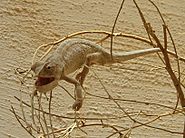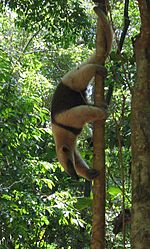Prehensile tail facts for kids

A prehensile-tailed spider monkey
A prehensile tail is the tail of an animal that has adapted to grasp or hold objects. Fully prehensile tails can be used to hold and manipulate objects, and in particular to aid arboreal creatures in finding and eating food in the trees. If the tail cannot be used for this it is considered only partially prehensile - such tails are often used to anchor an animal's body to dangle from a branch, or as an aid for climbing. The term prehensile means "able to grasp" (from the Latin prehendere, to take hold of, to grasp).
Contents
Animals with fully prehensile tails
Mammals
- New World monkeys. Many New World monkeys in the family Atelidae, which includes howler monkeys, spider monkeys and woolly monkeys, have grasping tails often with a bare tactile pad. This is in contrast with their distant Old World monkey cousins who do not have prehensile tails.
- Opossum. A marsupial group from the Americas. Video evidence exists of opossums using their prehensile tails to carry nesting material.
- Anteaters. Anteaters are found in Central and South America. Three of the four species of anteater, the silky anteater and the two species of tamandua, have prehensile tails
- Binturong. One of the few Old World animals with fully prehensile tails, although they use only the tip of the tail.
- Kinkajou. The kinkajou of South and Central America is the only other animal of the order Carnivora, besides the binturong, to sport the adaptation.
- Harvest mouse. Another old world mammal, the harvest mouse (Micromys minutus) also has a fully prehensile tail. It is commonly found amongst areas of tall grasses such as cereal crops (particularly wheat and oats), roadside verges, hedgerows, reedbeds, dykes and salt-marshes.
- New World porcupines of the genera Coendou and Chaetomys have fully prehensile tails that help them to climb and prevent them from falling from trees.
- Tree pangolin. One of the few Old World mammals with a fully prehensile tail.
- Microgale longicaudata, an arboreal species of tenrec.
Fish
- Seahorses. Seahorses have fully prehensile tails, which they use to attach themselves to objects such as seagrass, algae, sponges, corals, or even man-made objects.
Animals with partially prehensile tails
Mammals
- New World monkeys. The capuchin monkey. The capuchin is more than intelligent enough to make full use of its prehensile tail, but since the tail lacks an area of bare skin for a good grip it is only used in climbing and dangling. Other reasons for partial prehensility might include the lack of strength or flexibility in the tail, or simply having no need to manipulate objects with it.
- Tree porcupines. The 15 species of tree porcupine (genus Coendou). They are found in South America, with one species extending to Mexico. All have prehensile tails.
- Rats have been known to be able to wrap the tail around an object after running around it, therefore giving the creature a small bit of balance. They have also been seen to be able to briefly hang off an object, though not for long.
- Possums. This large, diverse group of 63 species forms the marsupial suborder Phalangeriformes, found in Australia, New Guinea, and some nearby islands. All members of the suborder have prehensile tails; however, the tails of some members such as the Acrobatidae have only limited prehensile capacity. Notably, all three marsupial glider groups belong to this suborder.
- Potoroidae. A marsupial group found in Australia that includes the bettongs and the potoroos. They have weakly prehensile tails.
- Monito del monte. A small South American marsupial with a prehensile tail.
Reptiles

Mediterranean chameleon using its prehensile tail
- Prehensile-tailed skink. Several kinds of skink (e.g. Corucia zebrata) have partially prehensile tails.
- Chameleon lizards.
- Snakes. Many snakes have prehensile tails (or a prehensile body)
- Crested gecko and their relatives have prehensile tails
- Urocoyledon rasmusseni. A gecko recently discovered in the Udzungwa mountains.
- Alligator lizard. Some alligator lizards such as the southern alligator lizard, the Texas alligator lizard, and the arboreal alligator lizards (genus Abronia) have prehensile tails.
- Big-headed turtle, and juvenile specimens of the family Chelydridae.
Amphibians
- Salamanders. A number of North American forest-dwelling climbing salamanders have prehensile tails that help them climb. Some are from the genus Aneides such as the clouded salamander (Aneides ferreus), the wandering salamander (Aneides vagrans), and the arboreal salamander (Aneides lugubris). Others are the large Red Hills salamander (Phaeognathus hubrichti) and the cave salamander (Eurycea lucifuga). There are also the Central American Bolitoglossa sombra and Mexican and Central American Bolitoglossa mexicana salamanders.
Fish
- Syngnathidae. Many species from this group, which includes seahorses and pipefish, have prehensile tails.
See also
 In Spanish: Cola prensil para niños
In Spanish: Cola prensil para niños

All content from Kiddle encyclopedia articles (including the article images and facts) can be freely used under Attribution-ShareAlike license, unless stated otherwise. Cite this article:
Prehensile tail Facts for Kids. Kiddle Encyclopedia.

